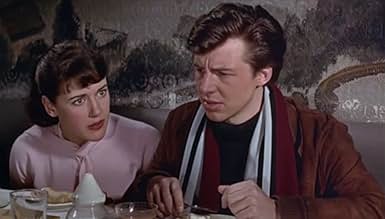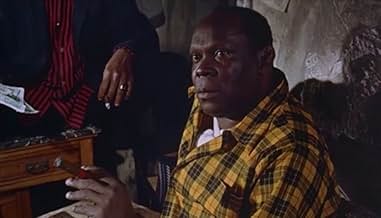VALUTAZIONE IMDb
7,2/10
2781
LA TUA VALUTAZIONE
L'omicidio di una giovane donna a Londra mette in luce le profonde tensioni razziali e i pregiudizi radicati nella zona.L'omicidio di una giovane donna a Londra mette in luce le profonde tensioni razziali e i pregiudizi radicati nella zona.L'omicidio di una giovane donna a Londra mette in luce le profonde tensioni razziali e i pregiudizi radicati nella zona.
- Ha vinto 1 BAFTA Award
- 3 vittorie e 4 candidature totali
Thomas Baptiste
- Man on the Street
- (non citato nei titoli originali)
Victor Brooks
- Police Sergeant
- (non citato nei titoli originali)
Marie Burke
- Second landlady
- (non citato nei titoli originali)
Recensioni in evidenza
The real problem with television broadcasting is that the better movies of the last century are held from the viewers. SAPPHIRE could be shown as a double bill with AN INSPECTOR CALLS. There are not enough movie buffs to push some of these classics so that they can be shown to today's audiences ..which would really appreciate them.
When a young woman's body is discovered on London's Hampstead Heath, the ensuing investigation quickly focuses on racial bigotry and hatred in 1950s Britain, exposing the prejudice amongst those under investigation AND those investigating.
Like so many other films from the 1940s and 1950s, Sapphire is yet another piece of groundbreaking British cinema now long forgotten. A little clunky and overly reliant on stereotyping by today's standards, but still a fascinating exploration of the fears and struggles inherent in a newly mixed-race society. Dearden has brought together an interesting cast here, cleverly giving matinée idol Craig a fairly unsympathetic role as a racist police officer, and being superbly served by Mitchell - her final scene is at once both compelling and distressing. Too many British cinema actors of the 40's and 50's have now been forgotten, and Mitchell is a prime example of why individual and collective reappraisals and retrospectives are long overdue.
Interesting companion piece to 1961's Flame In The Streets, then, and definitely worth catching if you can.
Like so many other films from the 1940s and 1950s, Sapphire is yet another piece of groundbreaking British cinema now long forgotten. A little clunky and overly reliant on stereotyping by today's standards, but still a fascinating exploration of the fears and struggles inherent in a newly mixed-race society. Dearden has brought together an interesting cast here, cleverly giving matinée idol Craig a fairly unsympathetic role as a racist police officer, and being superbly served by Mitchell - her final scene is at once both compelling and distressing. Too many British cinema actors of the 40's and 50's have now been forgotten, and Mitchell is a prime example of why individual and collective reappraisals and retrospectives are long overdue.
Interesting companion piece to 1961's Flame In The Streets, then, and definitely worth catching if you can.
I saw this movie (for the first time) when cable TV was new to Birmingham, Alabama. It was aired on a channel out of Chicago. Throughout the years, I have tried unsuccessfully to find a copy. Then...about three months ago, I found a collector with a copy in mint-condition. It has been well worth the money I spent. I watch it at least once a week. The cast worked very well together and the soundtrack is still hypnotic. The subject matter is addressed with a level of cinematic respect that makes the viewer sit up and take notice: no cursing and no lewd scenes...just raw and compelling acting. Like a bottle of old wine, Sapphire gets better and better as it ages. I'm hoping that no one will insult those of us who truly love this film by screening a cheesy re-make. That would be an insulting.
So who killed Sapphire. That's the movie's plot; however, the underlying theme is racial prejudice, a generally touchy topic at the time, even for British films. As I recall, the movie got more coverage than usual for a foreign release, at least in the LA area. The lovely Sapphire may look White, but genetically she's half-Black. Her troubles start when she "passes for White" in a London society still riven by prejudice. Engaged to the son of a reputable White family, her racial make-up causes rifts within the circle once her heritage is known. Naturally, the suspects start off with the family of her intended.
The twin threads of race and murder are skillfully woven into a difficult screenplay that nevertheless compels attention from start to finish. Credit a highly efficient performance from Nigel Patrick for holding together the disparate elements as his chief investigator works his way through London's many precincts. I like the way the screenplay portrays levels of racial dislike from both Whites and Blacks without getting too judgmental. Also, it looks like the exteriors were shot on location without any prettifying. Some of the neighborhoods in fact amount to about the last word in urban decay. Happily, director Deardon keeps things moving in unobtrusive fashion right down to the rather surprising finish. Anyway, the 90-some minutes amount to a topically compelling package that deserved its initial hoopla and still does.
The twin threads of race and murder are skillfully woven into a difficult screenplay that nevertheless compels attention from start to finish. Credit a highly efficient performance from Nigel Patrick for holding together the disparate elements as his chief investigator works his way through London's many precincts. I like the way the screenplay portrays levels of racial dislike from both Whites and Blacks without getting too judgmental. Also, it looks like the exteriors were shot on location without any prettifying. Some of the neighborhoods in fact amount to about the last word in urban decay. Happily, director Deardon keeps things moving in unobtrusive fashion right down to the rather surprising finish. Anyway, the 90-some minutes amount to a topically compelling package that deserved its initial hoopla and still does.
This is one of the most shocking films ever made about the true depths of colour prejudice in Britain in the 1950s, and the violent hatreds of black people harboured at that time by the white British working classes, especially in London. The film is well-scripted, and boldly directed by Basil Dearden, and it shows without flinching the true state of feeling as it was in those days (with some strong anti-white prejudice by blacks thrown in, to demonstrate that things are never only one way). What is so utterly horrifying about watching all of this now is, that it really was all true then. It is inevitable that some of the characters both white and black should resemble stereotypes, perhaps for the reason that at that time, people genuinely were stereotypes. The story concerns a police investigation of a murder of a young girl who was a student at the Royal Academy of Music (half way through the film a policeman calls it the Royal College of Music; Londoners are always confusing the two separate institutions in that way, so perhaps this script flaw merely reflects real life). Her body is found on Hampstead Heath in London, and there are no clues apart from the initial 'S' (her name is eventually discovered to be Sapphire). As a crime investigation thriller, the film is solid and extremely well done. A spectacular cameo performance is given by the black actor Robert Adams as 'Horace Big Cigar', not long before he died. The acting is all reliable and convincing. Dearden is especially good at not allowing any of the women and children to scream when discovering a body or having a horrible experience: his technique was extremely subtle, and they instead stifle screams, a scream begins to form, and then they put their own hands over their mouths in horror. When identifying a corpse, the actor behaves as one would naturally do, with numb paralysed shock, remaining silent and staring. All the ridiculous Hollywood histrionics and stock reactions of approved hysteria and screaming females are eliminated from this very British film, in which there is no place for hysteria except with one black character who panics for story reasons. Sociologists should really see this film. However, it is so incendiary that I cannot see it ever being released again or even being shown on television, at least not in Britain. In fact, some of the comments in the film may even have become 'illegal' under the harsh new race relations laws, even in a fictional context! Anyone who thinks race problems have gone away does not know human nature. Sensitivity to small differences, such as skin colour, is so firmly rooted in animal behaviour (the isolation by the herd of the black sheep, the driving away of albino animals from the pack), that race hatreds are inescapable, and can only be suppressed, never eradicated. Seeing this film reminds one of this depressing aspect of life by a blatant portrayal of it which is almost too painful to watch.
Lo sapevi?
- QuizThe success of this movie, in spite of its controversial themes, encouraged Janet Green to write Victim (1961), and Basil Dearden to direct it.
- BlooperThe ripped photo used as a clue appears in two versions from the first time it's discovered. The first version shows Sapphire laughing as she dances, with her mouth open. The second shows her smiling broadly with her jaw closed.
- Citazioni
[last lines]
Superintendent Robert Hazard: We didn't solve anything, Phil. We just picked up the pieces.
I più visti
Accedi per valutare e creare un elenco di titoli salvati per ottenere consigli personalizzati
- How long is Sapphire?Powered by Alexa
Dettagli
Botteghino
- Budget
- 400.000 USD (previsto)
- Tempo di esecuzione1 ora 32 minuti
- Proporzioni
- 1.66 : 1
Contribuisci a questa pagina
Suggerisci una modifica o aggiungi i contenuti mancanti
































